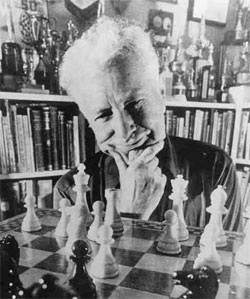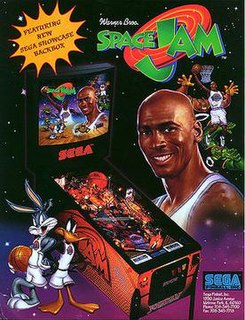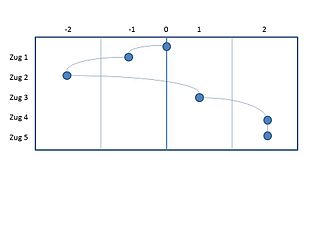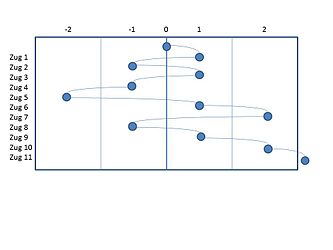Minimax is a decision rule used in artificial intelligence, decision theory, game theory, statistics, and philosophy for minimizing the possible loss for a worst case scenario. When dealing with gains, it is referred to as "maximin"—to maximize the minimum gain. Originally formulated for n-player zero-sum game theory, covering both the cases where players take alternate moves and those where they make simultaneous moves, it has also been extended to more complex games and to general decision-making in the presence of uncertainty.

A sphere is a geometrical object in three-dimensional space that is the surface of a ball. Like a circle in a two-dimensional space, a sphere is defined mathematically as the set of points that are all at the same distance r from a given point in a three-dimensional space. This distance r is the radius of the ball, which is made up from all points with a distance less than r from the given point, which is the center of the mathematical ball. These are also referred to as the radius and center of the sphere, respectively. The longest straight line segment through the ball, connecting two points of the sphere, passes through the center and its length is thus twice the radius; it is a diameter of both the sphere and its ball.

In mathematics, the p-adic number system for any prime number p extends the ordinary arithmetic of the rational numbers in a different way from the extension of the rational number system to the real and complex number systems. The extension is achieved by an alternative interpretation of the concept of "closeness" or absolute value. In particular, two p-adic numbers are considered to be close when their difference is divisible by a high power of p: the higher the power, the closer they are. This property enables p-adic numbers to encode congruence information in a way that turns out to have powerful applications in number theory – including, for example, in the famous proof of Fermat's Last Theorem by Andrew Wiles.

Pinball is a type of arcade game in which a player uses paddles to manipulate one or more balls inside a pinball machine. A pinball machine is a glass-covered cabinet containing a play field populated with lights, targets, bumpers, ramps, and various other objects depending on its design. The primary objective of the game is to score as many points as possible by hitting targets and making various shots with the flippers, before all balls "drain" at an exit usually situated at the bottom of the play field. Most pinball games are divided into turns. The game ends when all balls have ended.

The Elo rating system is a method for calculating the relative skill levels of players in zero-sum games such as chess. It is named after its creator Arpad Elo, a Hungarian-American physics professor.
Collision detection is the computational problem of detecting the intersection of two or more objects. Collision detection is a classic issue of computational geometry and has applications in various computing fields, primarily in computer graphics, computer games, computer simulations, robotics and computational physics. Collision detection algorithms can be divided into operating on 2D and 3D objects.

In mathematics, an affine algebraic plane curve is the zero set of a polynomial in two variables. A projective algebraic plane curve is the zero set in a projective plane of a homogeneous polynomial in three variables. An affine algebraic plane curve can be completed in a projective algebraic plane curve by homogenizing its defining polynomial. Conversely, a projective algebraic plane curve of homogeneous equation h(x, y, t) = 0 can be restricted to the affine algebraic plane curve of equation h(x, y, 1) = 0. These two operations are each inverse to the other; therefore, the phrase algebraic plane curve is often used without specifying explicitly whether it is the affine or the projective case that is considered.
A CW complex is a kind of a topological space that is particularly important in algebraic topology. It was introduced by J. H. C. Whitehead to meet the needs of homotopy theory. This class of spaces is broader and has some better categorical properties than simplicial complexes, but still retains a combinatorial nature that allows for computation. The C stands for "closure-finite", and the W for "weak" topology. A CW complex can be defined inductively.

Gridiron football, also known as North American football or, in North America, simply football, is a family of football team sports primarily played in the United States and Canada. American football, which uses 11-player teams, is the form played in the United States and the best known form of gridiron football worldwide, while Canadian football, featuring 12-player teams, predominates in Canada. Other derivative varieties include indoor football and Arena football, football for smaller teams, and informal games such as touch and flag football. Football is played at professional, collegiate, high school, semi-professional, and amateur levels.

Paper soccer is an abstract strategy game played on a square grid representing a soccer or hockey field. Two players take turns to extend a line representing the position of a ball, until it reaches one of the grid's two goal spaces. A traditional paper-and-pencil game, it is commonly played in schools and can be found in children's magazines. Many computer implementations of the game also exist. Despite the game's simple rules, paper soccer has several expanded strategies and tactics.
A glossary of terms, commonly used in discussing pinball machines.

Three-dimensional space is a geometric setting in which three values are required to determine the position of an element. This is the informal meaning of the term dimension.
In mathematics, ergodicity expresses the idea that a point of a moving system, either a dynamical system or a stochastic process, will eventually visit all parts of the space that the system moves in, in a uniform and random sense. This implies that the average behavior of the system can be deduced from the trajectory of a "typical" point. Equivalently, a sufficiently large collection of random samples from a process can represent the average statistical properties of the entire process. Ergodicity is a property of the system; it is a statement that the system cannot be reduced or factored into smaller components. Ergodic theory is the study of systems possessing ergodicity.

Chopsticks is a hand game for two or more players, in which players extend a number of fingers from each hand and transfer those scores by taking turns to tap one hand against another. Chopsticks is an example of a combinatorial game, and is solved in the sense that with perfect play, an optimal strategy from any point is known.
Doctor Who is a pinball machine designed by Bill Pfutzenreuter (Pfutz) and Barry Oursler, and released by Midway in September 1992. It is based on the television series Doctor Who. As stated in the Gameplay section, the rulesheet is rather different from other pinball machines released at the time, which didn't help popularity as casual players did not understand the complex rule changes that occur during the game.

Planet Puzzle League, known as Puzzle League DS in Europe, and as Panel de Pon DS in Japan, is a video game for the Nintendo DS handheld video game console in the Puzzle League/Panel de Pon visual matching puzzle game series. In North America, Planet Puzzle League is part of the Touch! Generations brand; in Japan, Panel de Pon DS is marketed in the general Touch! brand. The publisher for the game is Nintendo, and the developer is Nintendo second-party developer Intelligent Systems, creator of the original Panel de Pon and its cult classic English-language adaptation Tetris Attack. The game was released in Japan on April 26, 2007 in North America on June 4, 2007, and in Europe on June 29, 2007.

Space Jam is a 1996 pinball machine released by Sega Pinball. It is based on the film of the same name.
A topological game is an infinite game of perfect information played between two players on a topological space. Players choose objects with topological properties such as points, open sets, closed sets and open coverings. Time is generally discrete, but the plays may have transfinite lengths, and extensions to continuum time have been put forth. The conditions for a player to win can involve notions like topological closure and convergence.
The Banach–Tarski paradox is a theorem in set-theoretic geometry, which states the following: Given a solid ball in 3‑dimensional space, there exists a decomposition of the ball into a finite number of disjoint subsets, which can then be put back together in a different way to yield two identical copies of the original ball. Indeed, the reassembly process involves only moving the pieces around and rotating them without changing their shape. However, the pieces themselves are not "solids" in the usual sense, but infinite scatterings of points. The reconstruction can work with as few as five pieces.
Congestion games are a class of games in game theory first proposed by American economist Robert W. Rosenthal in 1973. In a congestion game the payoff of each player depends on the resources it chooses and the number of players choosing the same resource. Congestion games are a special case of potential games. Rosenthal proved that any congestion game is a potential game and Monderer and Shapley (1996) proved the converse: for any potential game, there is a congestion game with the same potential function.





























